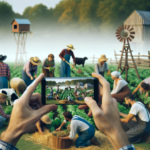“`html
Introduction to Email Newsletters
Ever wondered about the power of email newsletters and what makes them vital for your business? Or curious on how they can work in synergy with email farming to ensure your newsletters reach a wide audience? In this article, we’ll explore these topics and more, providing you a comprehensive understanding of email newsletters – why they matter, how to optimize them, and even how to monetize them effectively.
We’ll also discuss the role of farm newsletters and different elements that can make them engaging and informative for your subscribers. Lastly, we will shed light on how you can leverage email newsletters as a significant revenue stream for your business. It’s a lot to cover, so let’s get started!
Main Purpose of an Email Newsletter
Building Stronger Relationships with Customers
Email newsletters are important for nurturing customer relationships. Sending regular newsletters keeps your audience engaged with your brand.
Newsletters often include:
- Company updates
- Useful articles
- Exclusive offers
These elements help maintain a connection between your business and customers, ensuring you remain top-of-mind.
Driving Traffic to Your Website
One of the primary goals of an email newsletter is to drive traffic. Including links to your website can guide readers to:
- Blog posts
- Product pages
- Landing pages
This approach increases the likelihood of conversions and boosts your online presence.
Promoting Products and Services
Email newsletters offer a direct line to inform subscribers about new products or services. Highlighting features and benefits can encourage purchases.
Typical promotional content includes:
- New product launches
- Special discounts
- Limited-time offers
Subscribers feel valued when they receive exclusive deals, prompting loyalty and sales.
Gathering Valuable Feedback
Newsletters can also serve as a tool for collecting feedback. Engaging subscribers with surveys or polls provides insights into customer preferences.
Suggestions for feedback collection:
- Customer satisfaction surveys
- Product interest polls
- Suggestions for improvement
This information helps tailor your offerings to better meet customer needs. A useful resource on the importance of email newsletters can be found at HubSpot.
Enhancing Brand Awareness
Consistent email newsletters help build brand recognition. By providing valuable content, you reinforce your brand’s voice and messaging.
Tips for effective branding:
- Use a consistent design and color scheme
- Include your logo and tagline
- Maintain a uniform tone and style
This strategy makes your brand easily recognizable and trustworthy to your audience.
The Email Farming System
Understanding Email Farming
The email farming system, also known as email harvesting, refers to the process of collecting a large number of email addresses through various means. At its core, this method is about generating a comprehensive database of potential leads to nurture business opportunities.
Techniques of Email Farming
Like actual farming that involves cultivation, email farming also follows certain systematic processes. Here are few typical ones:
- Website scraping: An automated software sifts through numerous websites, the internet, blogs, and chat rooms looking for email addresses.
- Purchasing lists: Companies may buy lists with email addresses from third-party sources.
- Manual harvesting: It involves manually scavenging for email addresses from directories or other printed materials.
The Relevance of Email Farming to Newsletters
One may ask, how email farming is related to email newsletters? Well, a well-curated and large database generated through email farming serves as the foundation for sending out email newsletters effectively. By using a clean and robust email list, newsletters can reach a wider audience, driving better engagement and higher conversions
Maintaining Ethical Boundaries
Though email farming as a system can provide numerous advantages, it’s essential to maintain ethical boundaries. Unwanted emails can lead to spam issues and privacy complaints. Businesses should respect email marketing rules and regulations, such as the CAN-SPAM Act and the General Data Protection Regulation (GDPR), to ensure the legality of their actions.
Best practices could include:
- Securing explicit permission from email owners before sending promotional content
- Providing an easy unsubscribe option in every email
- Delivering valuable, relevant, and personalized content
An informative guide on the legalities involving email farming and communication can be accessed on Federal Trade Commission website.
Quality Over Quantity
While a large email list might seem attractive, it’s the quality of the list that eventually brings results. A robust email farming system should focus on obtaining high-quality email addresses, i.e., addresses belonging to users interested in your brand or service. This ensures that the email newsletters you send are welcomed, read, and acted upon, thus maximizing the benefits.
What to Put in a Farm Newsletter
Sharing Farm Updates
Keeping your subscribers informed about what’s happening on the farm builds a personal connection. Regular updates could include:
- Seasonal changes and their impact on produce
- New livestock additions
- Upgrades and improvements on the farm
These updates foster a sense of community and transparency, making readers feel more invested in your farm’s success.
Educational Content
Providing educational content can add significant value to your newsletter. Topics to consider include:
- Tips on sustainable farming practices
- How to grow a home garden
- Cooking recipes using your farm’s produce
Educational articles not only engage your audience but also position you as an authority in the farming industry.
Customer Testimonials and Stories
Featuring customer testimonials and stories is an excellent way to build trust and credibility. Consider including:
- Success stories from customers using your products
- Interviews with long-term subscribers
- Spotlights on loyal customers or partner businesses
These stories can demonstrate the real-world benefits of your products and services, making your newsletter more relatable and reliable.
Behind-the-Scenes Insights
Give your audience a peek behind the curtain with behind-the-scenes content. This could include:
- Day-to-day activities on the farm
- Meet the farmers and staff profiles
- The product lifecycle from farm to table
Behind-the-scenes insights can humanize your brand, making it more approachable and trustworthy.
Event Announcements
Announce and promote upcoming events in your newsletter. Event ideas might include:
- Farm tours
- Workshops and classes
- Seasonal festivals and markets
Events encourage community involvement and present opportunities for direct engagement with your customer base.
Weather Reports and Crop Forecasts
Farmers and those interested in agriculture often keep a close watch on the weather. Including weather reports and crop forecasts can be very useful. Consider sections like:
- Monthly weather outlooks
- Expected crop yields
- Advice on how weather conditions will affect your offerings
This content provides practical information that can help your readers plan and adjust their activities accordingly.
Exclusive Content for Subscribers
Reward your subscribers with exclusive content that they can’t get anywhere else. This could involve:
- Special discounts
- First access to new products
- Exclusive behind-the-scenes videos or interviews
Offering exclusive content makes your subscribers feel valued, encouraging loyalty and continued engagement.
For more tips on crafting effective farm newsletters, you can explore this comprehensive guide from HubSpot.
How do you make money from email newsletters?
Monetization Strategies for Email Newsletters
Email newsletters are not only about engagement but can also serve as a significant revenue stream for many businesses. Here’s how you can monetize your email newsletters effectively:
Paid Subscriptions
One of the most direct ways to earn money from your email newsletters is through paid subscriptions. In this model, subscribers pay a recurring fee to receive premium content.
Benefits include:
- Steady revenue stream
- High-quality, engaged audience
- Opportunity to offer tiered pricing
Sponsored Content
Businesses can charge other brands for featuring sponsored content or advertisements within their newsletters. Make sure sponsored content aligns with your audience’s interests to maintain trust and engagement.
Opportunities for sponsored content:
- Brand partnership announcements
- Sponsored articles or features
- Banner ads within the email
Affiliate Marketing
Incorporating affiliate marketing in your email newsletters can be highly profitable. By promoting products or services and including affiliate links, you earn a commission for every sale made through your link.
Key aspects:
- Choose relevant affiliate products
- Provide honest reviews and recommendations
- Disclose affiliate relationships to your audience
Exclusive Content and Offers
Offer exclusive content and special deals to your subscribers that they can’t get anywhere else. This not only adds value but also opens various monetization avenues.
Ideas for exclusive offers:
- Special discounts on products or services
- Early access to new products
- Exclusive eBooks, webinars, or courses
Promoting Your Own Products
Directly using your newsletter to promote your own products or services is a straightforward way to generate revenue. Highlight new arrivals, special promotions, or seasonal offers to drive sales.
Strategies for promotion:
- Feature product reviews and testimonials
- Include time-sensitive offers and discounts
- Create engaging product visuals and descriptions
For more profound insights, you can check HubSpot’s [guide on email marketing](https://www.hubspot.com/marketing/newsletter).
Event Registrations
Use your newsletter to promote and sell tickets for events, webinars, or courses that you host. This approach can generate revenue while also providing valuable content to your audience.
Event advertising tips:
- Provide detailed information about the event
- Encourage early bird registrations with discounts
- Use engaging visuals and compelling calls-to-action
Crowdfunding Campaigns
Leverage your newsletter to crowdfund for special projects or expansions. Platforms like Patreon allow your subscribers to support you monetarily in exchange for exclusive content or benefits.
Steps to successful crowdfunding:
- Clearly explain the purpose and benefits of the campaign
- Offer exclusive rewards for different levels of support
- Provide regular updates to keep supporters engaged
Wrapping It All Up
In conclusion, email newsletters serve diverse purposes that cater to both readers’ delight and business growth. They allow businesses to engage and connect intimately with their audience, driving traffic, promoting products, soliciting feedback and enhancing brand familiarity. Email farming, while a potent system for gathering addresses, should be executed ethically and responsibly.
Moreover, farm newsletters should strive to create an intimate connection with their readers, sharing farm updates, educational content, exclusive content, and weather reports. Additionally, when done right, email newsletters can also present substantial revenue streams by incorporating strategies like paid subscriptions, sponsored content, affiliate marketing, and event registrations.
Frequently Asked Questions – FAQs
What’s the main purpose of an email newsletter?
An email newsletter helps businesses build stronger relationships with customers, drive traffic to their website, promote products or services, gather valuable feedback, and enhance brand awareness.
What is email farming and its relevance to newsletters?
Email farming refers to the systematic process of collecting a large number of email addresses through various means. A robust email list is crucial to effectively distribute newsletters and improve engagement and conversions.
What kind of content is useful in a farm newsletter?
A farm newsletter can include content like sharing farm updates, educational material, customer testimonials, behind-the-scenes insights, event announcements, weather reports, and exclusive content for subscribers.
How can you monetize email newsletters?
You can monetize email newsletters through several strategies such as offering paid subscriptions, including sponsored content, engaging in affiliate marketing, offering exclusive content and deals, promoting your own products, and selling event registrations.
“`






